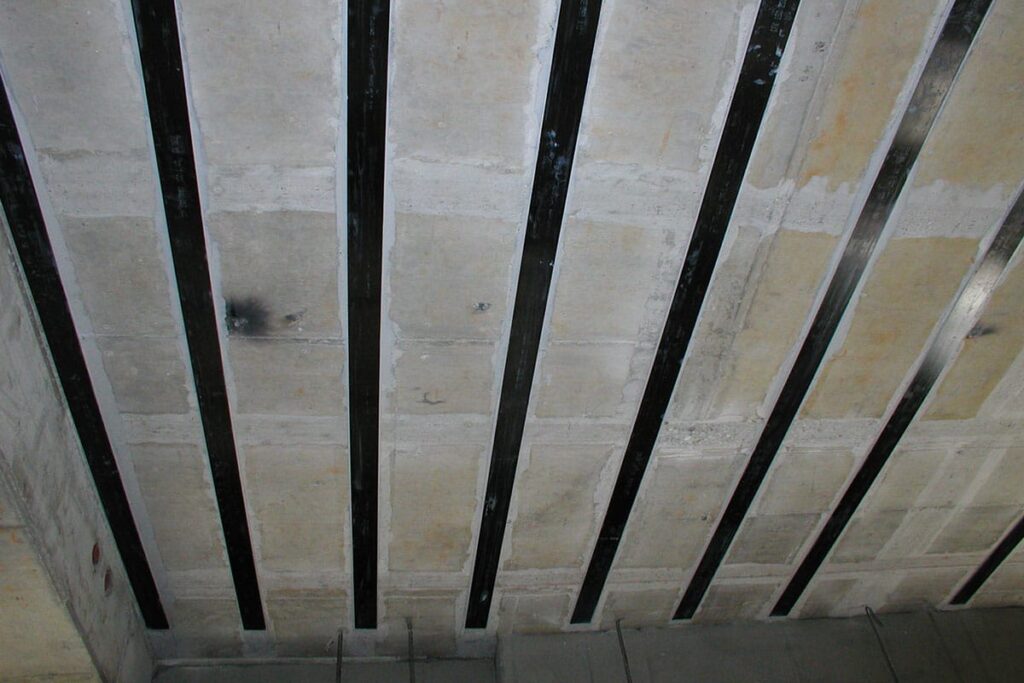Carbon Wrapping for slabs is a highly effective technique that significantly enhances the durability of concrete structures. In India, where ageing buildings and rapid urbanization pose challenges, this method offers an essential solution. It provides an efficient way to reinforce slabs without extensive reconstruction or demolition. Hence, it’s no wonder that engineers, contractors, and property owners are increasingly turning to this innovative approach.
The Basics of Carbon Wrapping for Slabs
Applying carbon fiber-reinforced polymer (CFRP) sheets to the exterior of concrete slabs is known as “carbon wrapping.” High-strength epoxy resins are used to connect these sheets, and they stick firmly to the slab surface. This method increases the existing slabs’ flexural strength and structural capability. It consequently becomes the preferred technique for strengthening structures without significantly increasing their weight. This lightweight approach is extremely useful in Indian cities, where space is a continual worry. Additionally, it excellently suits the requirements of both commercial and residential structures.
Increased Load-Bearing Capacity
The substantial increase in load-bearing capacity is one of the main benefits of carbon wrapping slabs. In India, a lot of older structures weren’t made to withstand the rigours of contemporary use, such as more machinery or more people. This method lowers the chance of structural failure by allowing current slabs to securely sustain additional loads. It is particularly helpful in industrial facilities, shopping centres, and hospitals. As a result, owners of real estate feel more secure knowing that their structures are safe despite shifting usage trends. It guarantees durability and continuous operation without requiring a full slab replacement.
Lightweight and Versatile Application
The lightweight nature of carbon wrapping for slabs is another strong advantage. Carbon fiber adds very little dead load, in contrast to more conventional techniques like steel plating or concrete overlays. In multi-story buildings, where extra weight could jeopardize overall stability, this is vital. Engineers can handle various forms, sizes, and surface conditions because of the application’s versatility. Carbon fiber readily adapts to both flat surfaces and intricate geometries. Because of its adaptability, it is a sensible option for India’s varied construction environment. As a result, contractors can use it in a variety of contexts, such as big business towers and residential flats.
Quick Installation with Minimal Disruption
In every building job, time is frequently a crucial component. Compared to conventional reinforcing techniques, carbon wrapping for slabs offers a quicker installation process. The application may usually be finished in a few days instead of weeks, which reduces downtime in the facility. This is especially helpful in India’s busy cities, where prolonged closures affect companies. Less interference in everyday life is advantageous to both owners and renters. Furthermore, the process runs more smoothly and is less invasive when there is no heavy machinery or noisy equipment around. As a result, it’s a practical option for occupied buildings and bustling business areas.
Durability and Long-Term Performance
Given India’s diverse climate, which ranges from inland heat to coastal dampness, durability is a top concern. Carbon Slab wrapping provides outstanding defence against environmental deterioration, moisture, and rust.
After application, it forms a barrier that protects the slab from adverse weather conditions. Over time, this lowers maintenance costs and increases the structure’s service life. Owners of real estate like the minimal maintenance needs, which ultimately results in financial savings. As a result, it’s a long-term solution that guarantees structural stability. Because of this, it is particularly appealing for projects in both urban and rural areas.
Seismic Resilience and Safety
Given India’s earthquake susceptibility, seismic resilience is of utmost importance. Carbon Slab wrapping improves a building’s resistance to seismic activity. It lowers the chance of an unexpected failure by improving the slab’s ductility and energy-absorbing capability. For buildings in high-risk areas like Gujarat, Delhi NCR, and portions of Maharashtra, this is essential. As a result, engineers can strengthen already-existing structures without making significant changes. This economical solution complies with safety regulations and national construction norms. As a result, property owners may protect residents and guarantee compliance.
Cost-Effective Strengthening Solution
In India, decisions about construction are frequently influenced by financial constraints. Carbon Slab wrapping is a more affordable choice than alternatives like total renovation. Shorter project deadlines, less labour, and fewer supplies are needed. Additionally, because of its lightweight design, foundations and columns don’t need to be strengthened. This lowers costs and complexity even more. Significant strength upgrades can be made by owners and developers without breaking the bank. It is therefore a wise investment that strikes a balance between affordability and performance. This explains why it’s becoming more and more well-liked in a variety of industries.
Aesthetic Advantages for Modern Spaces
Aesthetics are just as important in modern architecture as functionality. Carbon Slab wrapping provides structural support without sacrificing aesthetic beauty. The wraps are nearly undetectable because they are thin and can be painted or polished to match existing surfaces. In high-end residential and commercial settings, this is especially crucial. Without heavy reinforcements, owners may preserve neat lines and appealing finishes. As a result, the method appeals to today’s design-conscious audiences because it provides both safety and flair. It is hence ideal for contemporary Indian constructions.
Sustainable Construction Practices
In India, sustainability is increasingly being included in building projects. Slab carbon wrapping fits very nicely with environmentally responsible methods. It cuts down on waste by fortifying already existing structures rather than tearing them down and starting over. The procedure produces less construction detritus and uses fewer raw materials. This aids in meeting legal standards and promotes green building initiatives. Additionally, it reduces the carbon footprint that comes with new buildings. As a result, while improving infrastructure, developers and contractors can support environmental objectives. It is a desirable choice for contemporary constructions because of these two advantages.
Adaptability Across Building Types
India has a tremendously varied built landscape, ranging from contemporary high-rises to historic buildings. Carbon Slab wrapping is easily adjustable for these kinds of buildings. The approach is adaptable and can be used for anything from modernizing a brand-new office complex to strengthening a colonial building that is a century old. It can be modified to satisfy particular performance and design specifications. This flexibility guarantees improved safety for all projects, no matter how big or small. Engineers value flexibility because it enables them to successfully handle certain problems. As a result, it’s a sensible option for many different applications.
Quality Control and Professional Installation
Correct installation is essential to the effectiveness of carbon wrapping slabs. It takes talent to prepare the surface, apply the glue, and cure it. Indian contractors are currently becoming more skilled in this area, guaranteeing excellent results. To guarantee optimal practices, manufacturers also offer certification and training. Projects are guaranteed to satisfy safety and performance criteria because to this emphasis on quality control. As a result, property owners can trust that their reinforced slabs will remain reliable over time. This is particularly crucial for mission-critical organizations like hospitals and schools.
Carbon Wrapping for slabs is revolutionizing the way engineers reinforce structures in India’s rapidly changing construction industry. Increased load capacity, resistance to corrosion, ease of installation, and seismic resilience are among its unparalleled advantages. It is also affordable, adaptable, and sustainable—qualities that meet the demands of contemporary construction. This method satisfies Indian audiences’ demands for both safety and attractiveness. Quality control and appropriate installation are crucial to maximizing these advantages. Carbon Wrapping for slabs is a wise investment for engineers, developers, and property owners


